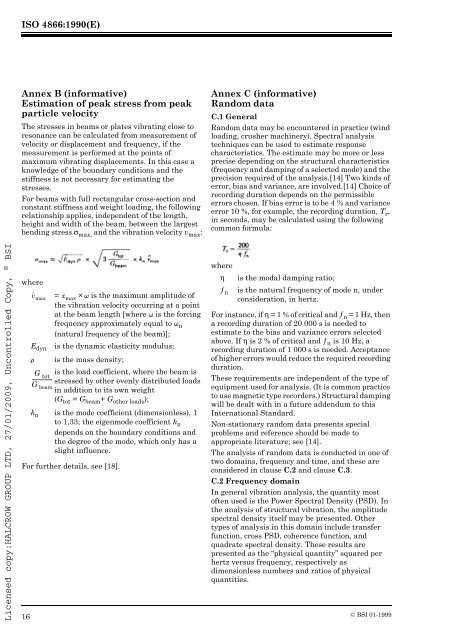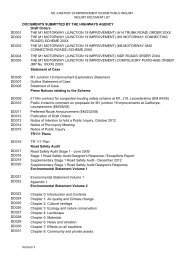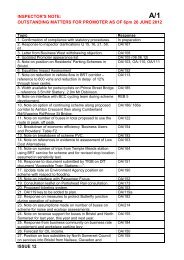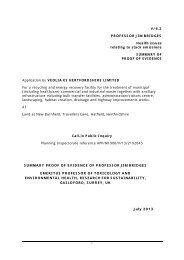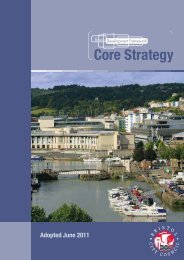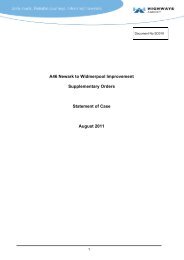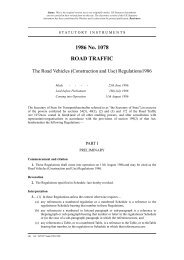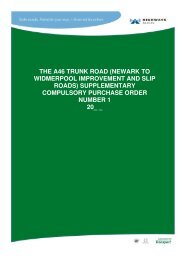Evaluation and Measurement for Vibration in Buildings Part 1, BSI ...
Evaluation and Measurement for Vibration in Buildings Part 1, BSI ...
Evaluation and Measurement for Vibration in Buildings Part 1, BSI ...
You also want an ePaper? Increase the reach of your titles
YUMPU automatically turns print PDFs into web optimized ePapers that Google loves.
ISO 4866:1990(E)<br />
Annex B (<strong>in</strong><strong>for</strong>mative)<br />
Estimation of peak stress from peak<br />
particle velocity<br />
The stresses <strong>in</strong> beams or plates vibrat<strong>in</strong>g close to<br />
resonance can be calculated from measurement of<br />
velocity or displacement <strong>and</strong> frequency, if the<br />
measurement is per<strong>for</strong>med at the po<strong>in</strong>ts of<br />
maximum vibrat<strong>in</strong>g displacements. In this case a<br />
knowledge of the boundary conditions <strong>and</strong> the<br />
stiffness is not necessary <strong>for</strong> estimat<strong>in</strong>g the<br />
stresses.<br />
For beams with full rectangular cross-section <strong>and</strong><br />
constant stiffness <strong>and</strong> weight load<strong>in</strong>g, the follow<strong>in</strong>g<br />
relationship applies, <strong>in</strong>dependent of the length,<br />
height <strong>and</strong> width of the beam, between the largest<br />
bend<strong>in</strong>g stress σ max, <strong>and</strong> the vibration velocity v max :<br />
Annex C (<strong>in</strong><strong>for</strong>mative)<br />
R<strong>and</strong>om data<br />
C.1 General<br />
R<strong>and</strong>om data may be encountered <strong>in</strong> practice (w<strong>in</strong>d<br />
load<strong>in</strong>g, crusher mach<strong>in</strong>ery). Spectral analysis<br />
techniques can be used to estimate response<br />
characteristics. The estimate may be more or less<br />
precise depend<strong>in</strong>g on the structural characteristics<br />
(frequency <strong>and</strong> damp<strong>in</strong>g of a selected mode) <strong>and</strong> the<br />
precision required of the analysis.[14] Two k<strong>in</strong>ds of<br />
error, bias <strong>and</strong> variance, are <strong>in</strong>volved.[14] Choice of<br />
record<strong>in</strong>g duration depends on the permissible<br />
errors chosen. If bias error is to be 4% <strong>and</strong> variance<br />
error 10 %, <strong>for</strong> example, the record<strong>in</strong>g duration, T r ,<br />
<strong>in</strong> seconds, may be calculated us<strong>in</strong>g the follow<strong>in</strong>g<br />
common <strong>for</strong>mula:<br />
Licensed copy:HALCROW GROUP LTD, 27/01/2009, Uncontrolled Copy, © <strong>BSI</strong><br />
where<br />
vˆ max<br />
E dyn<br />
r<br />
G<br />
tot<br />
-----------------<br />
G beam<br />
= xˆ max<br />
× v is the maximum amplitude of<br />
the vibration velocity occurr<strong>in</strong>g at a po<strong>in</strong>t<br />
at the beam length [where v is the <strong>for</strong>c<strong>in</strong>g<br />
frequency approximately equal to v n<br />
(natural frequency of the beam)];<br />
is the dynamic elasticity modulus;<br />
is the mass density;<br />
is the load coefficient, where the beam is<br />
stressed by other evenly distributed loads<br />
<strong>in</strong> addition to its own weight<br />
(G tot = G beam + G other loads );<br />
k n is the mode coefficient (dimensionless), 1<br />
to 1,33; the eigenmode coefficient k n<br />
depends on the boundary conditions <strong>and</strong><br />
the degree of the mode, which only has a<br />
slight <strong>in</strong>fluence.<br />
For further details, see [18].<br />
where<br />
For <strong>in</strong>stance, if η = 1 % of critical <strong>and</strong> ƒ n = 1 Hz, then<br />
a record<strong>in</strong>g duration of 20 000 s is needed to<br />
estimate to the bias <strong>and</strong> variance errors selected<br />
above. If η is 2% of critical <strong>and</strong> ƒ n is 10 Hz, a<br />
record<strong>in</strong>g duration of 1000 s is needed. Acceptance<br />
of higher errors would reduce the required record<strong>in</strong>g<br />
duration.<br />
These requirements are <strong>in</strong>dependent of the type of<br />
equipment used <strong>for</strong> analysis. (It is common practice<br />
to use magnetic type recorders.) Structural damp<strong>in</strong>g<br />
will be dealt with <strong>in</strong> a future addendum to this<br />
International St<strong>and</strong>ard.<br />
Non-stationary r<strong>and</strong>om data presents special<br />
problems <strong>and</strong> reference should be made to<br />
appropriate literature; see [14].<br />
The analysis of r<strong>and</strong>om data is conducted <strong>in</strong> one of<br />
two doma<strong>in</strong>s, frequency <strong>and</strong> time, <strong>and</strong> these are<br />
considered <strong>in</strong> clause C.2 <strong>and</strong> clause C.3.<br />
C.2 Frequency doma<strong>in</strong><br />
In general vibration analysis, the quantity most<br />
often used is the Power Spectral Density (PSD). In<br />
the analysis of structural vibration, the amplitude<br />
spectral density itself may be presented. Other<br />
types of analysis <strong>in</strong> this doma<strong>in</strong> <strong>in</strong>clude transfer<br />
function, cross PSD, coherence function, <strong>and</strong><br />
quadrate spectral density. These results are<br />
presented as the “physical quantity” squared per<br />
hertz versus frequency, respectively as<br />
dimensionless numbers <strong>and</strong> ratios of physical<br />
quantities.<br />
16<br />
© <strong>BSI</strong> 01-1999<br />
η<br />
ƒ n<br />
is the modal damp<strong>in</strong>g ratio;<br />
is the natural frequency of mode n, under<br />
consideration, <strong>in</strong> hertz.


